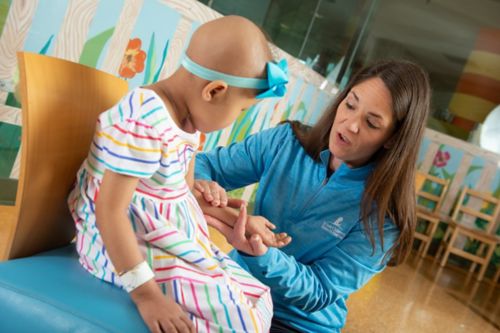Massage therapy helps relax the body and mind by rubbing, pressing, and moving the skin and muscles. Massage therapy can help reduce pain, discomfort, tension, and stress.
In babies, children, and teens with serious illness, the therapist will modify for softer touch and less intensity. Massage may use other techniques such as aromatherapy or heat therapy, but usually not with patients. Check with the therapist to know what to expect.
Types of massage therapy
Massage therapists may use one or more methods. Some common types include:
- Swedish massage is called “traditional” massage. It involves long sliding, stroking, kneading, friction, or tapping movements.
- Deep tissue massage is a full body massage to relieve muscle tension. It uses stronger, deeper pressure to address problems in muscles and tissue.
- Shiatsu is a practice in which the therapist applies pressure to certain points.
- Neuromuscular therapy involves pressure on trigger points to relieve pain and improve function.
- Reflexology is a type of massage a pressure applied to different points on the hands and feet.
Learn the difference between adult and pediatric massage therapy
Benefits of massage therapy
Benefits of massage therapy may include:
- Stress relief
- Better pain control
- Reduced nausea and vomiting
- Relaxation
- Improved blood flow
- Lower blood pressure
- Reduced symptoms of anxiety and depression
- Improved sleep
- Less fatigue and increased energy
- Improved sense of well-being
Massage may help children cope with illness. Caregivers may also benefit from having massage therapy.
Parents can learn how to do some types of massage. In pediatric massage, caregivers use storytelling to keep the child engaged. Massage may help deepen the parent-child connection. It can allow families to help manage symptoms.
Safety of massage therapy
Massage therapy is safe when done the right way by a trained professional. Licensed massage therapists have had formal education and meet requirements for government credentials. Some massage therapists have more training and certification.
Massage therapists may change methods to meet patient needs. They should avoid using hard pressure and avoid the area directly over a tumor or treatment site. Special care is needed for patients who have:
- Open wounds
- Bruised or irritated skin
- Blood clots, clotting disorders, or are on blood clot medication such as coumadin
- Low white blood cell counts
- Low platelet counts
- Bone fractures
- Cancer that has spread to bones
- Sensitive skin due to cancer treatments
- Lymphedema
- Peripheral neuropathy or other nerve pain
- Medical devices
Talk with the massage therapist beforehand. Be sure to:
- Check their credentials.
- Discuss medical needs and therapy goals.
- Find out what to expect.
- Ask questions and discuss any concerns.
Possible risks of massage therapy
Possible risks of massage therapy may include:
- Bruising
- Temporary swelling or pain in the muscles
- Allergic reactions to oils or lotions used during massage
Do not use massage as a replacement for standard treatments suggested by the care team.
Questions to ask your care team about massage therapy




